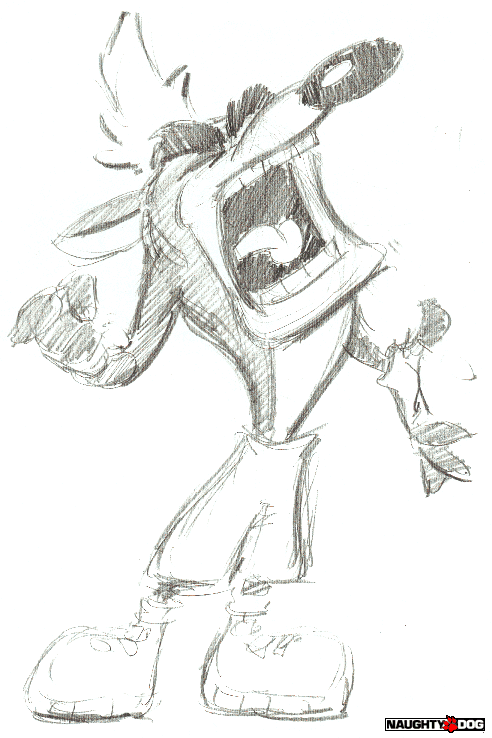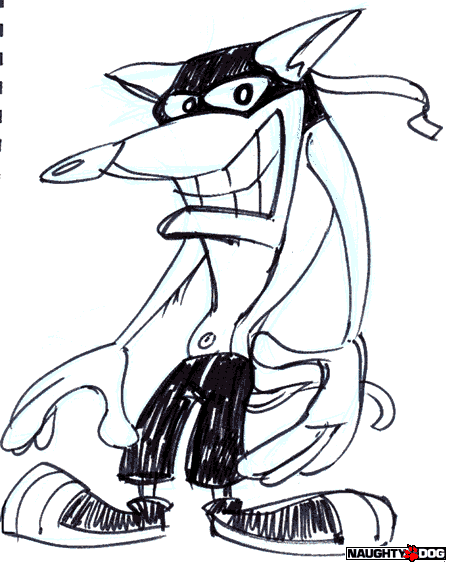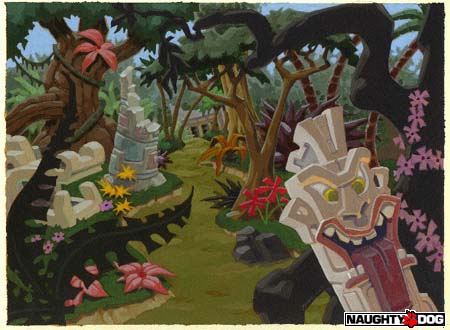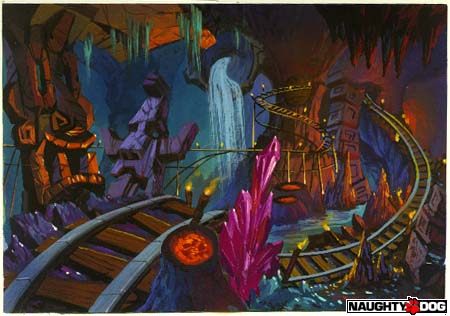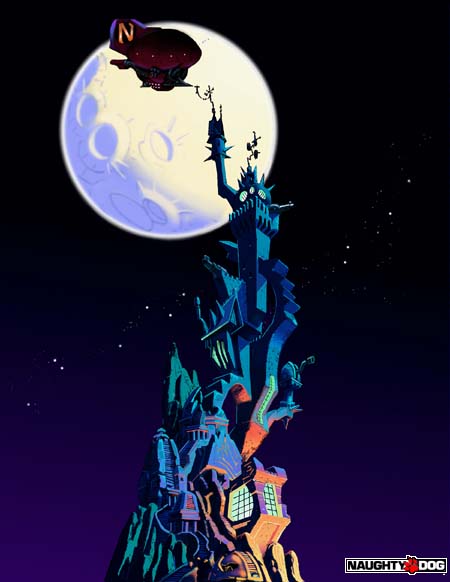This is part of a now lengthy series of posts on the making of Crash Bandicoot. Click here for the PREVIOUS or for the FIRST POST .
Dave Baggett, Naughty Dog employee #1 (after Jason and I) throws his own thoughts on Crash Bandicoot into the ring:
This is a great telling of the Crash story, and brings back a lot of memories. Andy and Jason only touch on what is to me the most interesting aspect of this story, which was their own relationship. When I met them, they had been making games together — and selling them — literally since middle school. I remember meeting Andy for the first time in April 1992, at an MIT AI Lab orientation. He knew as much as I did about games and programming, was as passionate about it as I was, and was equally commercially-minded. I just assumed meeting someone like this was a consequence of the selectivity of MIT generally and the AI Lab in particular, which accepts about 25 students each year from a zillion applicants.
In the long run I found that assumption was wrong: Andy and Jason were ultimately unique in my experience. None of us on the Crash 1 team realized it, but as a team we were very much outliers. At 23, Andy and Jason had commercial, strategic-thinking, and negotiating skills that far exceeded those of most senior executives with decades of experience. These, combined with their own prodigious technical talents and skillful but at times happenstance hiring, produced a team that not only could compete with Miyamoto, but in some ways outdo him. (More on this in a moment.)
 I still remember the moment I decided to bail on my Ph.D. and work for Andy and Jason as “employee #1”. I don’t think they saw themselves this way, but my archetype for them was John and Paul. (The Beatles, not the saints!) They were this crazy six-sigma-outlier yin/yang pair that had been grinding it out for literally years — even though they were still barely in their 20s. I knew these guys would change the world, and I wanted to be the George Harrison. One problem with this idea, however, was that they had been gigging together for so long that the idea of involving someone else in a really deep way — not just as an employee,but as a partner — was extremely challenging for them emotionally, and, I think, hard for them to conceptualize rationally from a business standpoint. This ultimately led to my leaving after Crash 2 — very sadly, but mostly for dispassionate “opportunity cost” reasons — though I continued to work with Josh Mancell on the music for Crash 3 and CrashTeam Racing, and remained close friends with all the ‘Dogs.
I still remember the moment I decided to bail on my Ph.D. and work for Andy and Jason as “employee #1”. I don’t think they saw themselves this way, but my archetype for them was John and Paul. (The Beatles, not the saints!) They were this crazy six-sigma-outlier yin/yang pair that had been grinding it out for literally years — even though they were still barely in their 20s. I knew these guys would change the world, and I wanted to be the George Harrison. One problem with this idea, however, was that they had been gigging together for so long that the idea of involving someone else in a really deep way — not just as an employee,but as a partner — was extremely challenging for them emotionally, and, I think, hard for them to conceptualize rationally from a business standpoint. This ultimately led to my leaving after Crash 2 — very sadly, but mostly for dispassionate “opportunity cost” reasons — though I continued to work with Josh Mancell on the music for Crash 3 and CrashTeam Racing, and remained close friends with all the ‘Dogs.
Andy and Jason had evolved a peculiar working relationship that the rest of the team found highly amusing. Jason would stomp around raging about this or that being terrible and Andy would play the role of Star Trek’s Scotty — everything was totally impossible and Jason couldn’t possibly appreciate the immense challenges imposed by what he was really asking for. (As a programmer myself, I generally took Andy’s side in these debates, though I usually hid in my office when the yelling got above a certain decibel level.) Eventually when matters were settled Andy usually pounded out the result in a 1/10th of the advertised time (also like Scotty). The rest of us couldn’t help but laugh at these confrontations — at times, Andy and Jason behaved like an old married couple. The very long work hours — literally 100-hour weeks — and the stress level definitely amplified everyone’s emotions, especially theirs.
On the subject of Mario 64, I agree more with Andy than with Jason, and think that Jason’s view highlights something very interesting and powerful about his personality. At the time I thought — and in retrospect, I still think — that Mario 64 was clumsy and ugly. It was the work of a great genius very much making a transition into a new medium — like a painter’s first work in clay. Going from 2D to 3D made all the technical challenges of games harder — for both conceptual and algorithmic reasons — and Miyamoto had just as hard a time as us adapting traditional gameplay to this new framework. The difference was that Miyamoto was an artist, and refused to compromise. He was willing and able to make a game that was less “fun” but more aggressively novel. As a result, he gave gamers their first taste of glorious 3D open vistas — and that was intoxicating. But the truth is that Mario 64 just wasn’t that fun; Miyamoto’s 2D efforts at the time — Donkey Kong Country and Yoshi’s Island — were far more fun (and, in fact, some of my personal favorite games of all time, though I never would have admitted that out loud at the time). As Andy said, the camera algorithms were awful; we had an incredibly hard time with camera control in our more constrained rails environment, and the problem wasn’t really technically solved for open environments like Mario 64’s until many years later. Mario 64’s collision detection algorithms were crap as well — collision detection suffers from a “curse of dimensionality” that makes it much harder in 3D than in 2D, as we also found. At Naughty Dog, we combined my ridiculously ambitious octree approach — essentially, dividing the entire world up into variable-sized cubes — with Mark’s godlike assembly coding to produce something *barely* fast enough to work — and it took 9 months. This was the one the one area on Crash when I thought we might actually just fail — and without Mark and I turning it into a back-and-forth coding throw-down, we probably would have. (As an aside, some coders have a savant-like ability to map algorithms onto the weird opportunities and constraints imposed by a CPU; only Greg Omi — who worked with us on Crash 2 — was in the same league as Mark when it came to this, of the hundreds of programmers I’ve worked with.)
 But Jason was tormented by Mario 64, and by the towering figure of Miyamoto generally. Like Andy Grove, Jason was constantly paranoid and worked up about the competition. He consistently underrated his — and our — own efforts, and almost neurotically overrated those of his competitors. I saw this trait later in several other great business people I worked with, and it is one I’ve found that, while maddening, correlates with success.
But Jason was tormented by Mario 64, and by the towering figure of Miyamoto generally. Like Andy Grove, Jason was constantly paranoid and worked up about the competition. He consistently underrated his — and our — own efforts, and almost neurotically overrated those of his competitors. I saw this trait later in several other great business people I worked with, and it is one I’ve found that, while maddening, correlates with success.
Fifteen years later, I’m now on my third startup; ITA Software followed Naughty Dog, and now I’m doing a raw startup again. The Naughty Dog model set the mold for all my future thinking about startups, and so far each one has followed a similar pattern: you must have a very cohesive, hard-working, creative team early on. This team of 6-12 sets the pattern for the company’s entire future — whether it grows to 50, 500, or — I can only assume — 5000 employees. The Crash 1 team was one of those improbable assemblages of talent that can never quite be reproduced. And unlike our contemporaries, our team got lucky: as Andy said, we were able to “slot in” to a very low-probability opportunity. Yes, Andy and Jason, with Mark, had identified the slot, and that was prescient. But many things had to go our way for the slot to still be genuinely available. The Crash team was an improbably talented team that exploited an improbable opportunity. As a life-long entrepreneur, I’ve lived to participate in — and, now, try to create — teams like that. There’s nothing more gratifying in business.
Part 8 CONTINUES here with another guest post.
| If you liked this post, follow me at:
My novels: The Darkening Dream and Untimed |
















